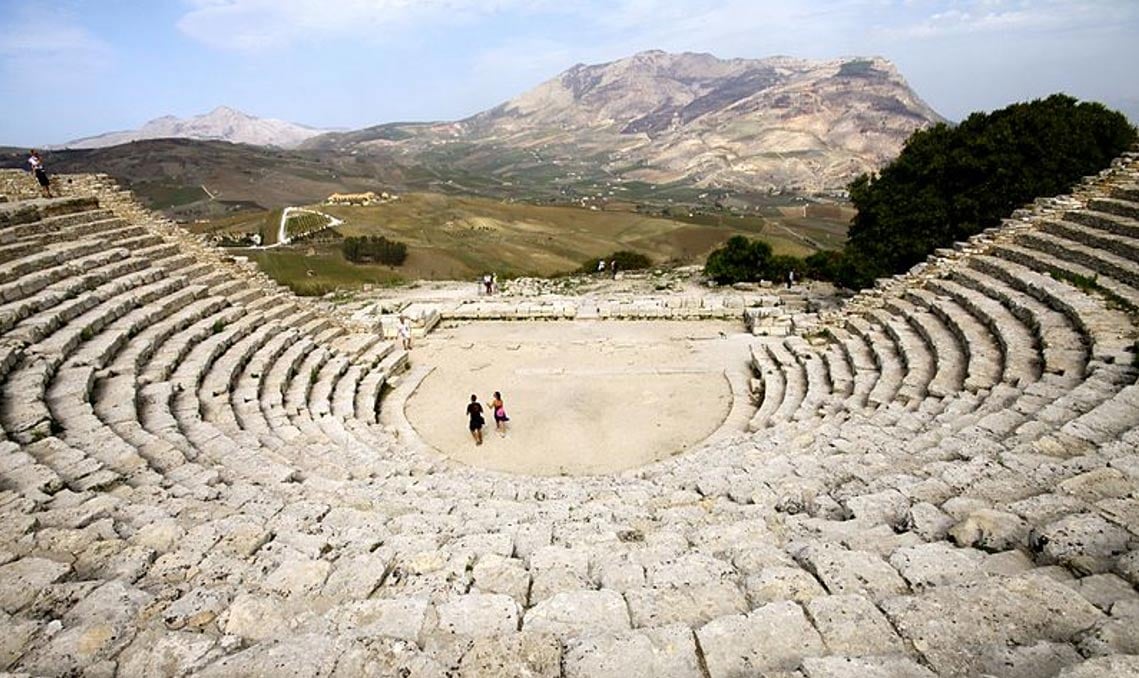Bryan Hill of Ancient Origins recently put up a very interesting article on ancient Hellenic theater and the monumental amphitheaters in honor of Dionysos. For the entire article, please visit the website linked above, but I want to post parts of the post here to wet your appitite, so to speak.
To the ancient Hellenes, theater was a form of entertainment taken very seriously. People would come from all across the Hellenic world to attend the popular theaters held in open air amphitheaters. In their glory days, some amphitheaters could hold crowds of up to 15,000 people, and some were so acoustically precise that a coin dropped at the center of the performance circle could be heard perfectly in the back row. The theater was a place where politics, religion, the human condition, popular figures, and legends were all discussed and performed with great enthusiasm. The origin of the dramatic arts in Greece would come in the 6th century BC, when the tyrant Pisistratus, who, at the time, ruled the city of Athens, established a series of public festivals. In the 6th century B.C. a priest of Dionysos, named Thespis, introduced a new element that is considered to be the birth of theater.
For a stage, the Greeks used the existing landscape around them. They found hillsides with large open spaces to construct stone amphitheaters with open sides and staggered rows of seats. Theater buildings were called 'theatrons' or 'seeing places' and consisted of three main elements: the orchestra, the skene, and the audience. The centerpiece of the theater, called the orchestra, was a large circular or rectangular area where the play, dance, religious rites and acting took place. The orchestra was placed on a level terrace at the base of a hill. Adjacent to it were doorways for actors and chorus members called paodio. These were tall arches that opened onto the orchestra in which the performers entered.
Situated behind the orchestra was the skene: a large rectangular building used as a backstage. In the beginning, the skene was a tent or hut but later it became a permanent stone structure. Here, actors would change their costumes and masks and these structures were sometimes painted to serve as backdrops.Rising from the circle of the orchestra was the audience. Because of the theater’s close connection with religion, they were often located in or near sanctuaries. For example, the Theater of Dionysos in Athens was situated in the sacred precinct of Dionysos at the foot of the Acropolis.
One particular theater, built to honor the god Dionysos, was called Epidaurus. It was the greatest theater in the western world and is considered a feat of engineering by today’s standards. Fifty five semi-circular rows of seats were built into the hillside with such precision that the theater has perfect acoustics. Two and a half thousand years later, it is still in use and is the largest of the surviving Hellenic theaters.
To the ancient Hellenes, theater was a form of entertainment taken very seriously. People would come from all across the Hellenic world to attend the popular theaters held in open air amphitheaters. In their glory days, some amphitheaters could hold crowds of up to 15,000 people, and some were so acoustically precise that a coin dropped at the center of the performance circle could be heard perfectly in the back row. The theater was a place where politics, religion, the human condition, popular figures, and legends were all discussed and performed with great enthusiasm. The origin of the dramatic arts in Greece would come in the 6th century BC, when the tyrant Pisistratus, who, at the time, ruled the city of Athens, established a series of public festivals. In the 6th century B.C. a priest of Dionysos, named Thespis, introduced a new element that is considered to be the birth of theater.
For a stage, the Greeks used the existing landscape around them. They found hillsides with large open spaces to construct stone amphitheaters with open sides and staggered rows of seats. Theater buildings were called 'theatrons' or 'seeing places' and consisted of three main elements: the orchestra, the skene, and the audience. The centerpiece of the theater, called the orchestra, was a large circular or rectangular area where the play, dance, religious rites and acting took place. The orchestra was placed on a level terrace at the base of a hill. Adjacent to it were doorways for actors and chorus members called paodio. These were tall arches that opened onto the orchestra in which the performers entered.
Situated behind the orchestra was the skene: a large rectangular building used as a backstage. In the beginning, the skene was a tent or hut but later it became a permanent stone structure. Here, actors would change their costumes and masks and these structures were sometimes painted to serve as backdrops.Rising from the circle of the orchestra was the audience. Because of the theater’s close connection with religion, they were often located in or near sanctuaries. For example, the Theater of Dionysos in Athens was situated in the sacred precinct of Dionysos at the foot of the Acropolis.
One particular theater, built to honor the god Dionysos, was called Epidaurus. It was the greatest theater in the western world and is considered a feat of engineering by today’s standards. Fifty five semi-circular rows of seats were built into the hillside with such precision that the theater has perfect acoustics. Two and a half thousand years later, it is still in use and is the largest of the surviving Hellenic theaters.


No comments:
Post a Comment